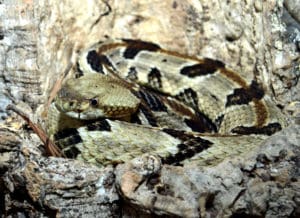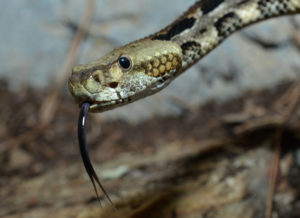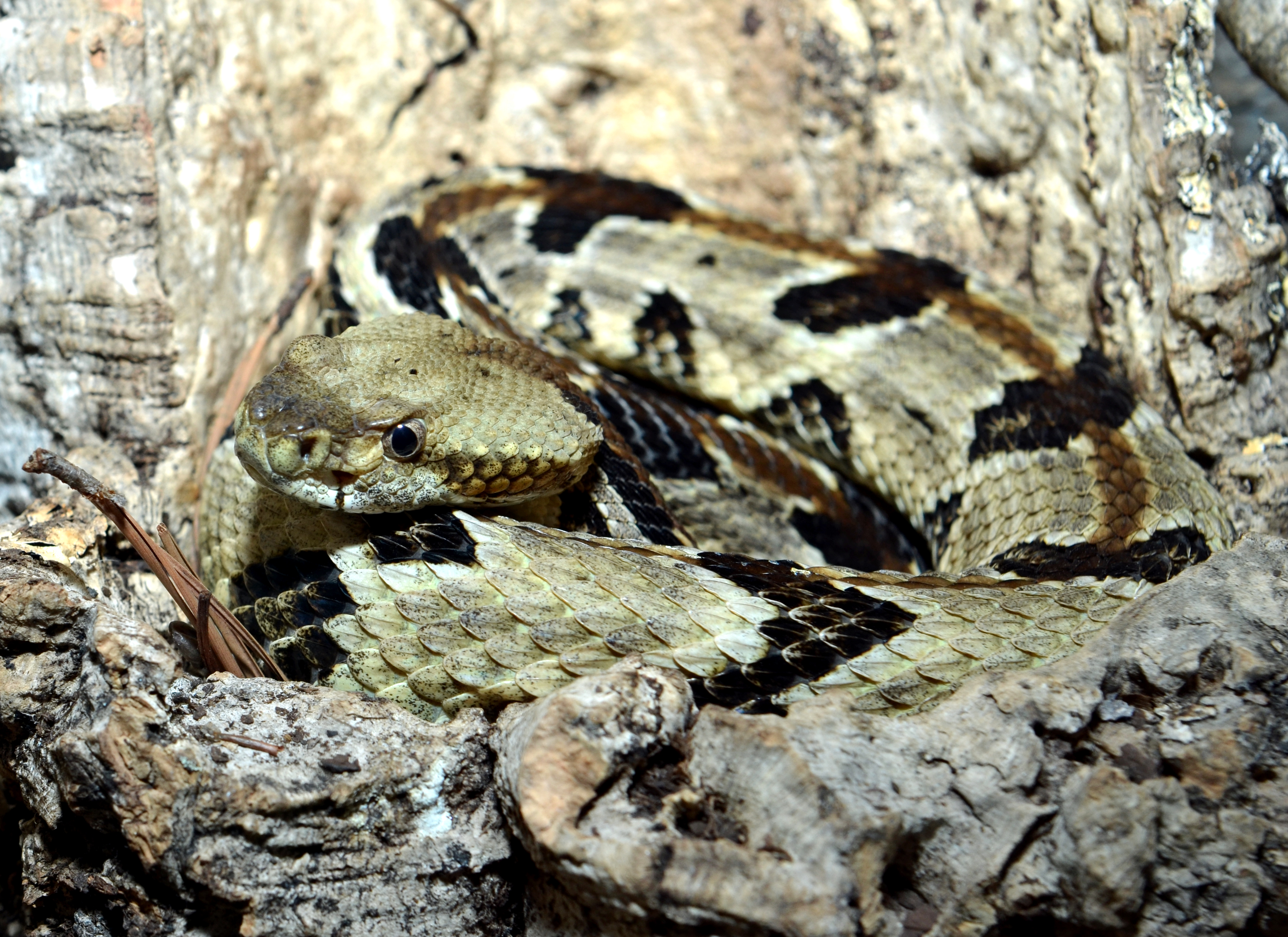Herp Highlight #10: Canebrake Rattlesnake
By Thomas Waser In Cold Blooded CreaturesOne of the VLM’s most popular reptile residents makes his home in our Mountain Cove habitarium. As first glance, he may go unnoticed by guests, as his colors blend in quite effectively with his surroundings, but disturb his wild brethren and you will hear the unmistakable sound of their warning. Waiting patiently to ambush his prey is our Canebrake Rattlesnake.


Photo Credit: Karl Rebenstorf
Yes, Virginia is home to rattlesnakes; in fact, some of them reside a little bit closer to the Virginia Living Museum than you may realize! Timber rattlesnakes (Crotalus horridus) typically range throughout the mountains of western Virginia, however an isolated population known as the Canebrake rattlesnake inhabits the south-east portion of the state. Though isolated and bearing a different name, they are indeed of the same species as the Timber, though debate continues regarding their status as a subspecies. Canebrake rattlesnakes can rarely be found in Newport News, most encountered around Sandy Bottom Nature park, though their numbers are dwindling due to human encroachment. The Canebrake has a Tier II Virginia Wildlife Action Plan Rating (Very High Conservation Need), meaning they face a high risk of extirpation (becoming extinct in one area but existing elsewhere).


Photo Credit: Karl Rebenstorf
Like Virginia’s other venomous snakes, the rattlesnake is a pit viper, named for the small pit that exists between the eye and nostril. The pit, combined with their cat-like slit pupils, allows the snake to sense prey even in complete darkness. Rattlesnakes are large bodied, and behave as ambush predators, lying in wait for days at a time for prey to come within reach. They then lash out with an incredibly fast strike, envenomating prey with their deadly venom (fun fact: a rattlesnake’s strike lasts between 44 and 70 milliseconds; by comparison, it takes you almost 200 milliseconds just to blink your eyes once!). Like all rattlesnakes, the Canebrake bears the signature rattle at the end of its tail to warn possible predators or unwary animals that may step on it, including humans.


Photo Credit: Karl Rebenstorf
Living in close proximity to such a formidable predator may raise some concerns, but you really don’t face any great danger from this snake. Though they do bear venom that can be potentially life-threatening to an adult human, several factors greatly diminish the risk posed by the Canebrake rattlesnake:
- They are incredibly uncommon in the eastern part of the state, and are rarely encountered by humans.
- They are fairly docile animals. They are not quick to anger and of course do not see humans as prey so they are not an actively aggressive species.
- They give plenty of warning. Because they need to conserve their precious venom for hunting prey, they prefer to warn predators/humans/animals away with their rattle. They generally will not strike unless left no other choice.
Most rattlesnake bites are sustained when an individual is trying to capture or kill a snake, or simply ignores its warning. However, while you are extremely unlikely to be harmed by a rattlesnake, it is possible you may be saved by one. Like many species of herptiles, the toxins of the rattlesnake are being studied for their medicinal potential; rattlesnake venom may be key to treating and preventing heart attacks and strokes by blocking the clotting of blood. The rattlesnake is certainly more friend than foe!
Some Rattlesnake Fun Facts!
- There is nothing inside a rattlesnake’s rattle – it’s completely hollow. The sound is made when the segments rub against each other!
- It is not possible to determine the snakes age by counting rattle segments, these are added when the snake sheds, and this can vary in frequency based on a multitude of conditions (they can also lose segments!).
- Rattlesnakes are ovoviviparous. The mother snake retains her eggs inside her body; after they hatch internally, she gives live birth to her young!


Want to meet our Canebrake rattlesnake and more awesome species like him? Be sure to stop by the museum March 16-17th for our annual Reptile Weekend! Countless species will be out on display with an an impressive venomous snake collection provided by Reptile Education of Virginia! Fun for the whole family!







James
There is no such thing as a cane break rattlesnake. It is actually called a timber rattlesnake. Cane break is just an IMPROPER SE regional common name. Similar to people calling a gray rat snake a chicken snake. There is no such thing as a chicken snake. They don’t exist.